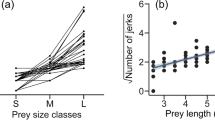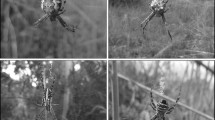Abstract
When green lacewings (Neuroptera: Chrysopidae) fly into spider orb webs, they often simply reverse their flight direction and pull away (Table I). If a lacewing is trapped, it uses a specialized escape behavior. It first cuts away the sticky strands entangling head, feet, and antennae. If an antenna cannot be freed by tugging, it uses an “antenna climb” (Fig. 5A). After its body is free, the lacewing remains suspended by its hair-covered wings, which are held in a characteristic cruciform position (Fig. 5B). Orb web sticky strands adhere poorly to the hairy wings (Fig. 7), so the chrysopid may just wait until the strands slide off and it falls free. If placed in an orb web when the spider is at the web hub and ready to attack, a lacewing usually does not have time to escape (Fig. 1). When the spider is at the hub but eating, the chances of escape improve, and when the spider is away from the hub attacking other prey, nearly all lacewings in our experiment were able to escape. This finding emphasizes the importance of the spider's activity in its capture success.
Similar content being viewed by others
References
Blum, M. S., Wallace, J. B., and Fales, H. M. (1973). Skatole and tridecene: Identification and possible role in a chrysopid secretion.Insect Biochem. 3: 353–357.
Brown, K. S. (1984). Adult-obtained pyrrolizidine alkaloids defend ithomiine butterflies against a spider predator.Nature 309: 707–709.
Craig, C. L. (1986). Orb-web visibility: The influence of insect flight behavior and visual physiology on the evolution of web designs within the Araneoidea.Anim. Behav. 34: 54–68.
Craig, C. L. (1987). The ecological and evolutionary interdependence between web architecture and web silk spun by orb web weaving spiders.Biol. J. Linn. Soc. 30: 135–162.
Craig, C. L., Okubo, A., and Andreasen, V. (1985). Effect of spider orb-web and insect oscillations on prey interception.J. Theor. Biol. 115: 201–211.
Denny, M. (1976). The physical properties of spider's silk and their role in the design of orb-webs.J. Exp. Biol. 65: 483–506.
Eberhard, W. G. (1986). Effects of orb-web geometry on prey interception and retention. In Shear, W. A. (ed.),Spiders: Webs, Behavior and Evolution, Stanford University Press, Stanford, Calif. pp. 70–100.
Eisner, T. (1982). For love of nature: Exploration and discovery at biological field stations.BioScience 32: 321–326.
Eisner, T., Alsop, R., and Ettershank, G. (1964). Adhesiveness of spider silk.Science 146: 1058–1061.
Gepp, J. (1984). Morphology and anatomy. In Canard, M., Séméria, Y., and New, T. R. (eds.),Biology of Chrysopidae, W. Junk, The Hague, pp. 9–36.
Hollander, M., and Wolfe, D. A. (1973).Nonparametric Statistical Methods, Wiley, New York, Chichester, Brisbane, Toronto, Singapore.
Larcher, S. F., and Wise, D. H. (1985). Experimental studies of the interactions between a web-invading spider and two host species.J. Aracknol. 13: 43–59.
Masters, W. M. (1984). Vibrations in the orbwebs ofNuctinea sclopertaria (Araneidae). I. Transmission through the web.Behav. Ecol. Sociobiol. 15: 207–215.
Masters, W. M., and Moffat, A. J. M. (1983). A functional explanation of top-bottom asymmetry in vertical orbwebs.Anim. Behav. 81: 1043–1046.
Nentwig, W. (1982). Why do only certain insects escape from a spider's web?Oecologia (Berl.) 53: 412–417.
Olive, C. W. (1980). Foraging specializations in orb-weaving spiders.Ecology 61: 1133–1144.
Rothschild, M., von Euw, J., and Reichstein, T. (1973). Cardiac glycosides in a scale insect (Aspidiotus), a ladybird (Coccinella) and a lacewing (Chrysopa).J. Entomol. 48: 89–90.
Sakan, T., Isoe, S., and Hyeon, S. B. (1970). The chemistry of attractants for Chrysopidae fromActinidia olygama Mig. In Wood, D. L., Silverstein, R. M., and Nakajima, M. (eds.).Control of Insect Behavior by Natural Products, Academic Press, New York, pp. 237–247.
Stern, H., and Kullmann, E. (1981).Leben am seidenen Faden, Kindler, Munich.
Thornhill, R. (1975). Scorpionflies as kleptoparasites of web-building spiders.Nature 258: 709–711.
Vollrath, F. (1979). Behavior of the kleptoparasitic spiderArgyrodes elevatus (Araneae, Theridiidae).Anim. Behav. 27: 515–521.
Author information
Authors and Affiliations
Additional information
Paper No. 88 of the series Defense Mechanisms of Arthropods.
Rights and permissions
About this article
Cite this article
Masters, W.M., Eisner, T. The escape strategy of green lacewings from orb webs. J Insect Behav 3, 143–157 (1990). https://doi.org/10.1007/BF01417908
Accepted:
Issue Date:
DOI: https://doi.org/10.1007/BF01417908




